Abstract
The accumulation of cadmium was investigated in two species of oysters [Crassostrea gigas (L.) and Ostrea edulis (L.)] from the same environment and in oysters of the same species (O. edulis) from two different environments (contaminated and uncontaminated), under controlled laboratory conditions (33‰ salinity, 10°C, 100 μg Cd l-1) for up to 111 d in 1982. C. gigas accumulated cadmium twice as fast as O. edulis (1.07 vs 0.52 μg Cd g-1 wet wt d-1). Furthermore, O. edulis from an uncontaminated environment accumulated cadmium faster than O. edulis from a metal-contaminated environment (0.52 vs 0.34 μg Cd g-1 wet wt d-1). There was no effect of cadmium exposure on total soft-tissue copper and zinc concentrations. Investigation of cytosolic metal-binding using Sephadex G-75 gel-permeation chromatography indicated that binding to very low molecular weight ligands (MW<1000) accounted for>70% of the cytosolic zinc in all oysters and>40% of the cytosolic cadmium in all oysters except O. edulis from Conwy at 83 d. In copper-contaminated oysters, excess copper was also associated with very low molecular weight ligands. Intermediate molecular weight cadmium/copper-binding proteins (similar to metallothionein in molecular weight) were observed in the cytosol and were shown to differ between species in terms of their behavior on Sephadex G-75. Finally, the distribution of accumulated cytosolic cadmium in O. edulis from the contaminated environment was shown to have a unique distribution, i.e., there was no cadmium associated with high molecular weight cytosolic macromolecules. The data indicate that both genetic and environmental factors influence cadmium accumulation in oysters.
Similar content being viewed by others
Literature cited
Boyden, C. R. and D. J. H. Phillips: Seasonal variation and inherent variability of trace elements in oysters and their implications for indicator studies. Mar. Ecol. Prog. Ser. 5, 29–40 (1981)
Coombs, T. L.: The nature of zinc and copper complexes in the oyster Ostrea edulis. Mar. Biol. 28, 1–10 (1974)
Denton, G. R. W. and C. Burdon-Jones: Influence of temperature and salinity on the uptake, distribution and depuration of mercury, cadmium and lead by the black-lip oyster Saccostrea echinata. Mar. Biol. 64, 317–326 (1981)
George, S. G., B. J. S. Pirie, A. R. Cheyne, T. L. Coombs and P. T. Grant. Detoxication of metals by marine bivalves: an ultrastructural study of the compartmentation of copper and zinc in the oyster Ostrea edulis. Mar. Biol. 45, 147–156 (1978)
George, S. G., B. J. S. Pirie and J. M. Frazier: Effects of cadmium exposure on metal-containing amoebocytes of the oyster Ostrea edulis. Mar. Biol. 76, 63–66 (1983)
Greig, R. A.: Trace metal uptake by three species of mollusks. Bull. envir. Contam. Toxicol. 22, 643–647 (1979)
Jackim, E., G. Morrison and R. Steele: Effects of environmental factors on radiocadmium uptake by four species of marine bivalves. Mar. Biol. 40, 303–308 (1977)
Pringle, B. H., D. E. Hissong, E. L. Katz and S. T. Mulawka: Trace metal accumulation by estuarine mollusks. J. sanit. Engng Div. Am. Soc. civ. Engrs 94, 455–475 (1968)
Ridlington, J. M. and B. A. Fowler: Isolation and partial characterization of a cadmium-binding protein from the American oyster (Crassotrea virginica). Chem. biol. Interactions 25, 127–138 (1979)
Ruddell, C. L. and D. W. Rains: The relationship between zinc, copper and the basophils of two crassostreid oysters, C. gigas and C. virginica. Comp. Biochem. Physiol. 51A, 585–591 (1975)
Zamuda, C. D. and W. G. Sunda: Bioavailability of dissolved copper to the American oyster Crassostrea virginica. I. Importance of chemical speciation. Mar. Biol. 66, 77–82 (1982)
Author information
Authors and Affiliations
Additional information
Communicated by J. Mauchline, Oban
Rights and permissions
About this article
Cite this article
Frazier, J.M., George, S.G. Cadmium kinetics in oysters — a comparative study of Crassostrea gigas and Ostrea edulis . Marine Biology 76, 55–61 (1983). https://doi.org/10.1007/BF00393055
Accepted:
Issue Date:
DOI: https://doi.org/10.1007/BF00393055




